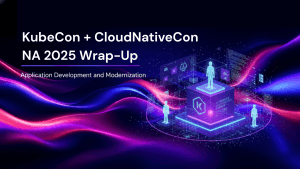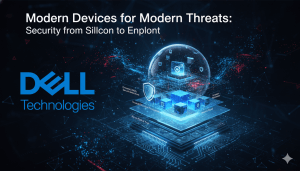AI Matures, Platforms Evolve, and Cloud-Native Enters Its Next Era
KubeCon North America 2025 arrived in Atlanta under unusual and unforgettable circumstances. With a government shutdown creating uncertainty around federal travel and flight operations, and with an unexpected cold front sending temperatures into the low 20s, the event began on a note of unpredictability. After watching airline schedules wobble, Paul and I made the call to drive which ended up being a great decision filled with a surprisingly productive rolling strategy session.
For me, the cold was a personal affront as it always is. But at least this time I had come prepared with melatonin to avoid the sleep troubles of past KubeCons. But I was pleasantly surprised to see a Benadryl vending machine inside the conference center, something so distinctly American that Paul and I joked you’d never find one in London. Between the cold, the long drive, and the chaos, the week still delivered exactly what KubeCon always does: a clear pulse on where cloud-native technology is heading next.
And this year, the direction was unmistakable.
AI has become inseparable from cloud-native modernization, reshaping infrastructure, operations, developer experience, and platform strategy. The announcements reflected not a single trend but a convergence of them. AI automation, GPU efficiency, security at scale, multicloud abstraction, a more mature approach to platform engineering, oh my!
Below is our full analysis of the biggest themes, supported by the detailed coverage we published throughout the week. And make sure to check out all of the video coverage we were able to get throughout the week!
Agentic Workflows Take Over the SDLC
If 2024 was the year AI infiltrated cloud-native tools, 2025 is the year AI became the operator. The strongest signal from the show floor was the normalcy with which developers, platform teams, and vendors now talk about agentic automation. Instead of AI assisting specific tasks, it is increasingly orchestrating full workflows.
Google illustrated this shift clearly with its evolution of GKE for agentic workloads, emphasizing rapid inference setup and workflow acceleration. Union.ai reinforced this trend by positioning Flyte V2 as a unified control plane for agent-driven production systems. A sign that workflow engines are becoming orchestration hubs for everything from model training to retrieval to inference pipelines.
On the operational side, Akuity demonstrated how AI-powered automation reduces cognitive load and preempts issues before SREs even notice them, while Last9 introduced agentic observability workflows to accelerate troubleshooting and recovery. Cosmonic advanced the security dimension of this shift with wasmCloud 2.0, ensuring AI-agent governance and isolation sits directly inside the runtime fabric.
Even data movement and search were reframed through an AI lens. Airbyte expanded from analytics pipelines into AI agent enablement, highlighting how ELT pipelines must adapt to agent-driven inference, while OpenSearch showcased how LLM-driven search and observability can refine operational context.
Cloud Foundry took a developer-centric angle with new buildpacks supporting Prompt-to-Cloud development paths, a strong indicator that AI workflows are now expected at the build stage and not as afterthoughts.
And Nirmata brought policy automation into the fold with an AI-driven platform engineering assistant that can generate, validate, and refine governance rules at scale.
Together, these announcements paint a unified picture where AI agents are becoming the backbone of how those systems operate and not just layered on top.
GPU Efficiency, Virtualization & Hybrid Compute: AI Infrastructure Grows Up
With AI models escalating in complexity and cost, organizations are shifting from “add more GPUs” to “use GPUs more intelligently.” This year’s announcements strongly reflected that evolution.
vCluster introduced one of the clearest examples of this maturity with its infrastructure tenancy platform, designed specifically to enhance multi-tenant GPU efficiency within Kubernetes. Spectro Cloud contributed to this theme by unveiling Palette AI, a capability focused on compressing deployment timelines and preventing GPU hoarding across teams.
Mirantis took a significant step into virtualization with a new platform built on k0rdent, emphasizing GPU isolation via virtualization, MIG slicing, and automated cleanup. A multi-layered approach aimed at enterprise-grade AI governance. Zesty then shifted the conversation toward automated optimization with a 5x performance boost to Karpenter, a notable improvement for organizations trying to efficiently scale clusters under AI workloads.
Broader infrastructure strategy also came into focus. OVHcloud leaned heavily into cloud repatriation, calling attention to customers shifting workloads back to hybrid environments for sovereignty and cost predictability. Vultr launched its VX1 compute platform along with a conversational provisioning agent, signaling a clear ambition to democratize GPU access across cloud regions and tenants.
And because databases sit squarely in the AI development loop, Yugabyte’s focus on cloud-native Postgres for iterative AI cycles stood out as a foundational capability for teams building LLM-driven applications.
The thread across these vendors is consistent: AI infrastructure is evolving from “accumulation” to “efficient orchestration,” reflecting a deeper understanding of AI’s operational realities.
Observability Shifts from Collection to Understanding
Observability continued its transition from data-heavy dashboards to business-centric, insight-rich systems that minimize noise and accelerate action.
Chronosphere set the tone here with its pivot from an all-in-one model to a composable observability ecosystem, embracing specialized partners and AI-guided troubleshooting workflows. Dynatrace advanced its long-running strategy around autonomous observability, enhancing its capability to preemptively detect anomalies using continuous behavioral analytics.
Splunk delivered one of the biggest architectural shifts of the event, decoupling ingestion, transformation, and analysis through OpenTelemetry Injecture and a new independent data model. An important milestone in freeing customers from rigid ingestion paths.
Last9’s agentic automation (also seen in the AI theme) further demonstrated how observability is morphing from “after-the-fact investigation” to “before-the-impact prevention.”
CloudBolt also contributed by bridging observability with cost transparency through container-level cost allocation, helping teams diagnose financial inefficiencies at the same depth as performance issues.
This evolution signals an industry acknowledging that more data doesn’t equal more clarity, and that AI-assisted analysis, not massive aggregation, is the new competitive edge.
Security Becomes Developer-Centric and AI-Governed
Security at KubeCon 2025 centered around two major shifts:
(1) authorization and identity woven directly into application logic, and
(2) operational security converging with AI governance.
AuthZed stood out by positioning SpiceDB Enterprise as a modern authorization backbone for multi-agent, multi-service architectures. A requirement for AI-era applications that must verify identity at each interaction. Teleport added clarity to the operator experience with new visual RBAC mapping and AI-assisted security investigations, helping teams reduce time-to-understanding during incidents.
Minimus disrupted the supply-chain conversation by offering contractual zero-CVE guarantees backed by distroless, continuously rebuilt images. Cloudsmith echoed this focus with security-first artifact management and dependency governance workflows.
Buoyant extended Linkerd to support the Model Context Protocol (MCP) and expanded its service mesh to Windows, aligning mesh governance with emerging AI-driven communication standards. Replicated tackled the fast-growing self-hosted AI segment, providing a secure path for distributing on-prem and air-gapped AI workloads.
The overall message was that security modernization must evolve in lockstep with AI modernization since neither can succeed without the other.
Platform Engineering Reaches Maturity
Platform engineering has been one of the most discussed trends for two years, but at this KubeCon it felt fully formed. The story is now about refining them as cohesive, productized experiences.
Nirmata’s AI-driven policy assistant represented this maturation at the governance layer. Cloud Foundry’s expansion into AI-enabled buildpacks showed how developers can start AI workflows from the very first interaction with the platform. Spectro Cloud, vCluster, and Mirantis demonstrated how GPU orchestration and virtualization are converging into platform responsibilities, not siloed tasks.
CNCF broadened the profession’s talent foundation by expanding to 15 vendor-neutral certifications, reflecting the reality that platform engineering now spans operations, security, observability, and AI disciplines.
VMware and Canonical reinforced upstream-first strategy with a partnership focused on consolidating Kubernetes management and reducing lifecycle complexity. LocalStack’s multi-cloud emulation provided consistent developer experience across cloud APIs regardless of provider. And Percona closed a critical feature gap in Postgres by introducing transparent data encryption, ensuring data governance aligns with platform requirements.
Platform engineering is no longer a movement, it’s a discipline. And the tooling finally reflects the responsibilities teams carry.
Edge, WebAssembly & Distributed Compute Expand Their Footprint
This KubeCon also reinforced the reality that the edge is no longer a niche domain. Edge is now one of the fastest-growing frontiers of distributed compute.
Fermyon continued the maturation of WebAssembly with its CNCF donation and expansion with Akamai, highlighting performance, modularity, and portability as core benefits for edge-native applications. ZEDEDA extended its edge orchestration logic with AppFlows and AI-driven operational enhancements, emphasizing the need for unified control across geographically distributed environments.
And wasmCloud’s evolution under Cosmonic reinforced how distributed runtime architectures are converging around lightweight, secure, multi-runtime execution.
The edge story at KubeCon showed how, as applications become more intelligent, the infrastructure around them must become more flexible, portable, and decentralized.
Community, Collaboration & the Human Side of KubeCon
Amid all the technical discussions, it wouldn’t be KubeCon without strong community energy. Chronosphere hosted one of the most memorable events of the week. Ciroos brought together interesting conversation over dinner, Amber Rowland treated us to a fantastic vegan meal, and Mindshare PR also hosted a wonderful evening. All of these were the icing on an otherwise intensely busy week.
And of course, CNCF delivered yet another flawlessly orchestrated event despite the governmental and weather challenges surrounding it.
Looking Ahead to 2026: True Rapid Application Development Arrives
For Paul, who authored Rapid Application Development for Dummies almost a decade ago, this KubeCon felt validating. The promise of faster development cycles, intelligent automation, and simplified infrastructure that was once aspirational is now reflected directly in the products on display.
Going into 2026, we expect:
- Agentic automation to become standard for platform, SRE, and developer workflows
- GPU and virtualization efficiency to remain top IT priorities
- Observability to shift fully toward insights and prevention
- Multi-cloud consistency to matter more than multi-cloud presence
- AI governance and security to merge into unified operational tiers
And, most importantly… KubeCon Europe 2026 will take place in Amsterdam in March… right over Sam’s birthday.
So when you see us next year, be sure to stop by, talk about AI modernization, and wish Sam a happy birthday at the event.
See you in Amsterdam.



